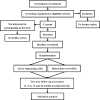Modified pedicle screw placement at the fracture level for treatment of thoracolumbar burst fractures: a study protocol of a randomised controlled trial
- PMID: 30696677
- PMCID: PMC6352792
- DOI: 10.1136/bmjopen-2018-024110
Modified pedicle screw placement at the fracture level for treatment of thoracolumbar burst fractures: a study protocol of a randomised controlled trial
Abstract
Introduction: The optimal treatment for burst fractures of the thoracolumbar spine is controversial. The addition of screws in the fractured segment has been shown to improve construct stiffness, but can aggravate the trauma to the fractured vertebra. Therefore, optimised placement of two pedicle screws at the fracture level is required for the treatment of thoracolumbar burst fractures. This randomised controlled study is the first to examine the efficacy of diverse orders of pedicle screw placement and will provide recommendations for the treatment of patients with thoracolumbar burst fractures.
Methods and analysis: A randomised controlled trial with blinding of patients and the statistician, but not the clinicians and researchers, will be conducted. A total of 70 patients with single AO type A3 or A4 thoracolumbar fractures who are candidates for application of short-segment pedicle screws at the fractured vertebral level will be allocated randomly to the distraction-screw and screw-distraction groups at a ratio of 1:1. The primary clinical outcome measures will be the percentage loss of vertebral body height, screw depth in the injured vertebrae and kyphosis (Cobb angle). Secondary clinical outcome measures will be complications, Visual Analogue Scale scores for back and leg pain, neurological function, operation time, intraoperative blood loss, Japanese Orthopaedic Association score and Oswestry Disability Index. These parameters will be evaluated preoperatively, intraoperatively, on postoperative day 3, and at 1, 3, 6, 12 and 24 months postoperatively.
Ethics and dissemination: The Institutional Review Board of the Second Affiliated Hospital and Yuying Children's Hospital of Wenzhou Medical University have reviewed and approved this study (batch: LCKY2018-05). The results will be presented in peer-reviewed journals and at an international spine-related meeting after completion of the study.
Trial registration number: NCT03384368; Pre-results.
Keywords: fracture level; modified placement; pedicle screws; thoracolumbar burst fractures.
© Author(s) (or their employer(s)) 2019. Re-use permitted under CC BY-NC. No commercial re-use. See rights and permissions. Published by BMJ.
Conflict of interest statement
Competing interests: None declared.
Figures



References
-
- Parker JW, Lane JR, Karaikovic EE, et al. . Successful short-segment instrumentation and fusion for thoracolumbar spine fractures: a consecutive 41/2-year series. Spine 2000;25:1157–70. - PubMed
-
- Alanay A, Acaroglu E, Yazici M, et al. . Short-segment pedicle instrumentation of thoracolumbar burst fractures: does transpedicular intracorporeal grafting prevent early failure? Spine 2001;26:213–7. - PubMed
Publication types
MeSH terms
Associated data
LinkOut - more resources
Full Text Sources
Medical
